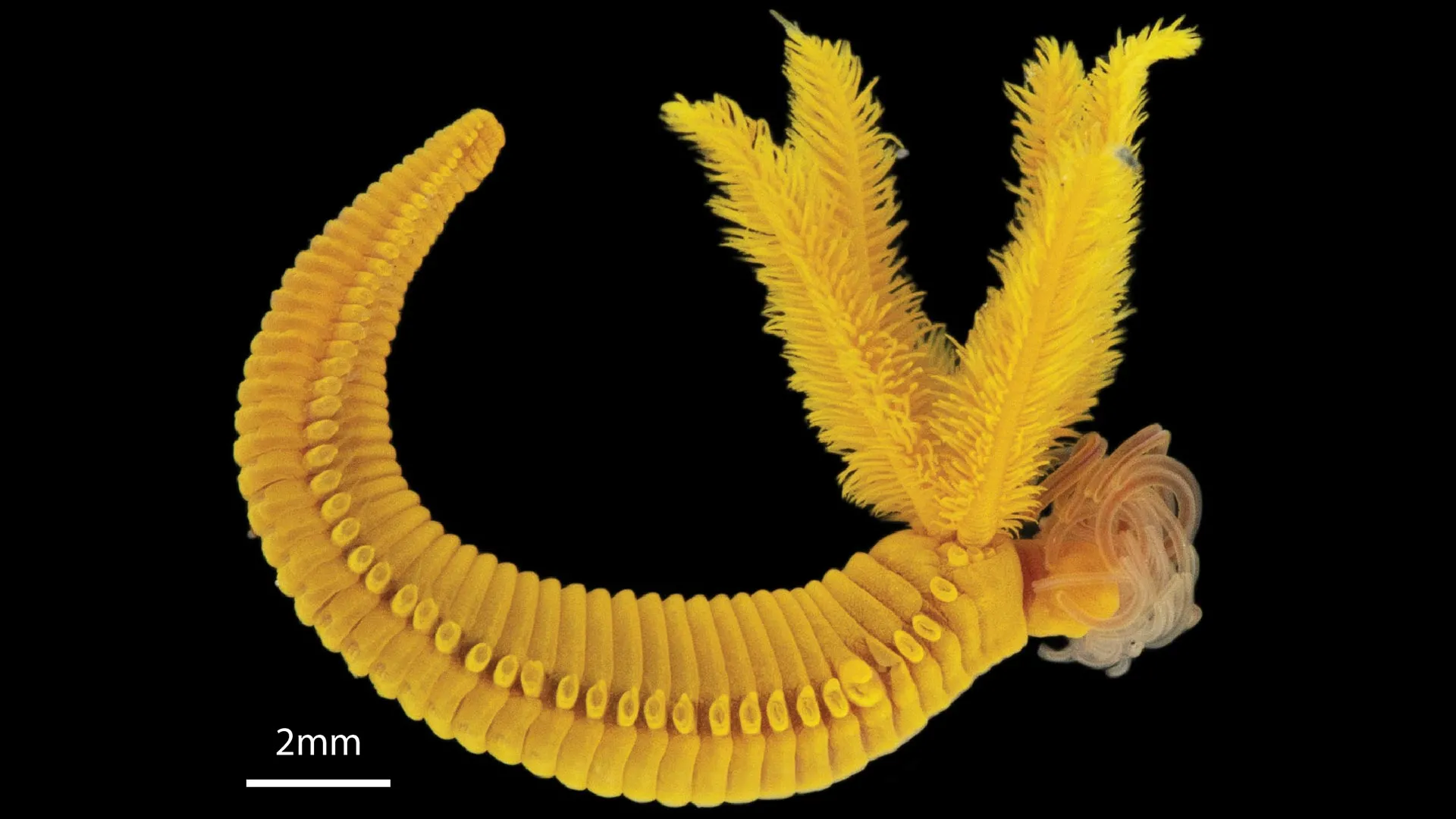The bright yellow worm that turns ocean poison into golden survival crystals
The hydrothermal vent worm converts the toxins in its cells into less toxic mineral.
- Date:
- August 27, 2025
- Source:
- PLOS
- Summary:
- Deep beneath the Pacific Ocean, a bright yellow worm thrives where no other animals dare, in toxic hydrothermal vents saturated with arsenic and sulfide. By cleverly turning these poisons into a golden mineral once prized by Renaissance painters, the worm neutralizes the deadly threat and survives in one of Earth’s most hostile habitats. Scientists say this unusual “fighting poison with poison” strategy could change how we think about life’s resilience in extreme environments.
- Share:

A deep sea worm that inhabits hydrothermal vents survives the high levels of toxic arsenic and sulfide in its environment by combining them in its cells to form a less hazardous mineral. Chaolun Li of the Institute of Oceanology, CAS, China, and colleagues report these findings in a new study published August 26th in the open-access journal PLOS Biology.
The worm, named Paralvinella hessleri, is the only animal to inhabit the hottest part of deep sea hydrothermal vents in the west Pacific, where hot, mineral-rich water spews from the seafloor. These fluids can contain high levels of sulfide, as well as arsenic, which builds up in the tissues of P. hessleri, sometimes making up more than 1% of the worm's body weight.
Li and his team investigated how P. hessleri can tolerate the high levels of arsenic and sulfide in the vent fluids. They used advanced microscopy, and DNA, protein and chemical analyses to identify a previously unknown detoxification process. The worm accumulates particles of arsenic in its skin cells, which then react with sulfide from the hydrothermal vent fluids to form small clumps of a yellow mineral called orpiment.
The study provides new insights into the novel detoxification strategy that P. hessleri uses for "fighting poison with poison," which enables it to live in an extremely toxic environment. Previous studies have found that related worms living in other parts of the world, as well as some snail species in the west Pacific, also accumulate high levels of arsenic, and may use this same strategy.
Coauthor Dr. Hao Wang adds, "This was my first deep-sea expedition, and I was stunned by what I saw on the ROV monitor -- the bright yellow Paralvinella hessleri worms were unlike anything I had ever seen, standing out vividly against the white biofilm and dark hydrothermal vent landscape. It was hard to believe that any animal could survive, let alone thrive, in such an extreme and toxic environment."
Dr. Wang says, "What makes this finding even more fascinating is that orpiment -- the same toxic, golden mineral produced by this worm -- was once prized by medieval and Renaissance painters. It's a curious convergence of biology and art history, unfolding in the depths of the ocean."
The authors note, "We were puzzled for a long time by the nature of the yellow intracellular granules, which had a vibrant color and nearly perfect spherical shape. It took us a combination of microscopy, spectroscopy, and Raman analysis to identify them as orpiment minerals -- a surprising finding."
The authors conclude, "We hope that this 'fighting poison with poison' model will encourage scientists to rethink how marine invertebrates interact with and possibly harness toxic elements in their environment."
Funding: This work was supported by grants from Natural Science Foundation of China (No. 42476133 to H.W.), Science and Technology Innovation Project of Laoshan Laboratory (Project Number No. LSKJ202203104 to H.W.), National Key RandD Program of China (Project Number 2018YFC0310702 to H.W.), Natural Science Foundation of China (Grant No. 42030407 to C.Li), and the NSFC Innovative Group Grant (No. 42221005 to M.X.W.). The funders had no role in study design, data collection and analysis, decision to publish, or preparation of the manuscript.
Story Source:
Materials provided by PLOS. Note: Content may be edited for style and length.
Journal Reference:
- Hao Wang, Lei Cao, Huan Zhang, Zhaoshan Zhong, Li Zhou, Chao Lian, Xiaocheng Wang, Hao Chen, Minxiao Wang, Xin Zhang, Chaolun Li. A deep-sea hydrothermal vent worm detoxifies arsenic and sulfur by intracellular biomineralization of orpiment (As2S3). PLOS Biology, 2025; 23 (8): e3003291 DOI: 10.1371/journal.pbio.3003291
Cite This Page: